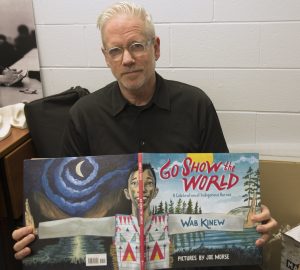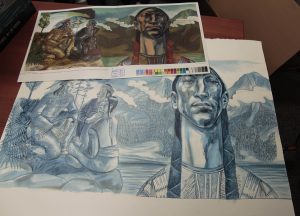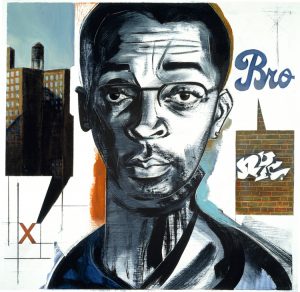
BY MICHELLE BILTON
Sheridan professor and coordinator of the Illustration program knows the career of an illustrator isn’t easy, but it can be rewarding.
Joe Morse was shortlisted for his artwork in Go Show the World: A Celebration of Indigenous Heroes, written by Wab Kinew. The picture book was up for the 2018 Governor General Literary Awards (GGBooks), in the young people’s literature – illustrated books category. While it didn’t end up winning, it has received national recognition from the nomination. They Say Blue by Jillian Tamaki won the award in this category.

The GGBooks award was established by Governor General Lord Tweedsmuir and the Canadian Authors Association. Authors, illustrators and translators win $25,000 if they’re selected by the peer assessment committee. The committee is made up of professionals within the industry. The members this year were Adwoa Badoe, Renata Liwska and Hugh MacDonald.
According to Tara Lapointe, director, outreach and business development, Canada Council for the Arts, for young people’s literature – illustrated Books, the only criteria was literary and artistic merit.
“The members of the peer assessment committee evaluated the text and the illustrations and how well the two components complement one another. They identified Go Show the World: A Celebration of Indigenous Heroes as one of the five best books submitted to the competition,” says Lapointe.
Morse was thrilled by the nomination and emphasized the significance of the book being nominated.
“I really saw the weight, from my standpoint, of responsibility on this because as I worked through it, Canada was going through the 150th. There was a lot of discussion about our relationship and reconciliation and all these kinds of things that we, as a nation, need to deal with. I really saw this project to be an important one, but to get the nomination it confirms that,” says Morse.
He believes that this book contributes to educating Canadians, especially children. “The philosophy behind it and the idea of Wab and I working together, I’m non-indigenous and he’s Anishinaabe, us working together on a project that is directed both to indigenous and non-indigenous kids is a real important part of my life right now,” he says.
The novel focuses on well-known indigenous heroes including Jim Thorpe and Carey Price, but also people Morse says he couldn’t research because Kinew discovered them through the oral tradition. He and Kinew hope this book will help teachers who are struggling to bring positive stories of indigenous life into the classroom.
“It was really critical for him, he would like to see a world where when we talk about the people that are in this book, that we don’t say they’re indigenous heroes, we say they’re heroes,” he says.
Kinew recently created a guide for teachers planning to introduce the book into a classroom, due to many teachers asking for one.
Morse has now illustrated five children’s books. He has won more than 200 international awards and has done illustrations for organizations including Nike, Coca-Cola, Universal Pictures, RollingStone, Entertainment Weekly, the New York Times and the Guardian. He knows success within the arts doesn’t come easily.
He remembers the moment he knew this was the right career for him. “When I was a child, I was in school, the first time I did a picture and I got a positive response, I was sold,” he says.
As the youngest of seven kids, he wanted to do something unique. “I didn’t go to school to be an illustrator, I thought that I was going to work as a fine artist. But I found more and more that my work pushed towards narrative and telling stories. I’m not more of a fantasy artist in any respect. I’m much more interested in documentary, non-fiction or real stories that have some connection to people and their lives.”
Morse ended up learning illustration on-the-job, which he doesn’t recommend to do today. He says there were more opportunities for illustrators in the ’80s working at newspapers and small publications.
He says it’s a challenge to find work as an artist, but artists should see the challenge as an opportunity. “The nice thing, as an illustrator, opposed to a visual artist, a visual artist would make work and try and sell that work, I don’t pick up a paintbrush until I know what I’m getting paid,” he says.
He loves to see how his work impacts people and says it inspires him to create. “I received a letter from an inmate in Maryland, who’s in penitentiary, he wrote about my first kids book, Casey at the Bat, and he said, ‘I don’t know if you’ll ever get this letter, I don’t want anything, I just want to say I read this book, it was on my cell block, I read it and it’s really affected my life,’ ” says Morse.
He also recalls when he was working on a portrait of American film director Spike Lee for RollingStone and received a phone call from Lee. “He was really interested in how, as a white guy in Canada, how did I do that? How did I figure that out? I just gave him a sense of what an illustrator is and what we come from, what we’re about, it’s all about research but it’s also about really trying to get into the sensibility and the visual world of a character or the person we’re involved with. You’re trying to bring research to life,’ ” says Morse.

After everything he has done, Morse still has big plans for his future. “I’d like to write a book. I teach life drawing, I’m really interested in doing a book on drawing and thinking. When I look at our educational system, that’s one of the things we don’t teach, is drawing,” he says.
He adds that he’d like to work on a project with his wife and two kids, who are also artists.
